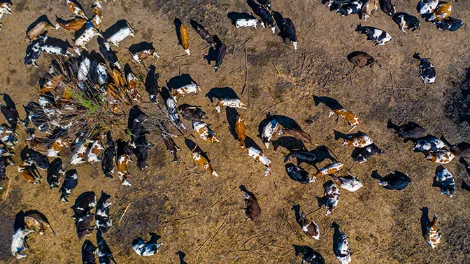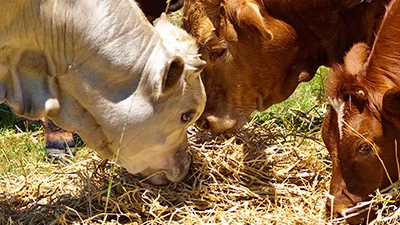

Once again, it has been a mixed season for the grain growing regions in Australia.
During May/June, above average rainfall across regions in South Australia (SA), Victoria (VIC) and southern New South Wales (NSW) replenished soil moisture levels, and created favourable planting and growing conditions.
However, Western Australia (WA) and northern NSW had drier than average conditions in their growing areas, eventuating in most growers dry sowing crops.
Glencore Agriculture Domestic Grain Merchant, David Wood, believes that with drier conditions forecasted before harvest, the Australian grain industry is readying itself for another harvest of uncertainty and potential new challenges.
A repeat of last year
“Last year, there were many questions in the lead up to harvest around how the industry would cope and adapt to handle conditions caused by the drought,” David said.
“It was clear early on last season, that the eastern states were not going to produce enough to supply their 13 million tonnes of demand for both human and animal consumption, so focus turned to the other states to see how much they would produce and how it could be transported to meet the demand.”
The uncertainty around production levels, and the possibility of transporting grain interstate caused prices to skyrocket, as the market panicked about the amount of grain available in the system.
However, the grain supply chain adapted and managed the situation, and millions of tonnes of grain moved from the west to east coast domestic markets.
Despite the grain production forecasts showing a supply deficit on the east coast, which should require grain movements again this year, David said that he doesn’t expect prices will reach the same levels as previously seen.
“Last year, everyone was very worried about how grain supply chains would cope with moving grain interstate rather than to traditional export markets, and this uncertainty caused prices to rise.
“Although we are entering the 2019/20 harvest with a similar level of hesitation around production, we now know that if need be, the grain supply chain can quickly adapt. We already know how to manage the task of transporting Australian grain interstate to where it is needed, and because of this, I don’t think we will see the same prices that we saw last year.”
International imports
Another factor that could potentially contain the price of grain this year is the possibility for further international imports.
In 2019, the first import of wheat in over a decade entered the country via Port Kembla, NSW, after a large milling group was issued an import permit from the Australian Government for a shipment of high protein milling wheat sourced from Canada.
“The import of wheat from Canada not only lowered domestic market prices when it was first received, as it meant increased supply to meet demand, but it could also have an impact on prices in the future,” said David.
“If grain prices go up again, then it raises the chances of buyers looking elsewhere to international markets to source the grain they need. Now there is a process in place to have a permit issued, buyers could use that as an example and put the same measures in place to be accepted.
“For the Department of Agriculture, as long as they feel biosecurity risks are being managed then they could allow future imports.”
The first international import followed strict movement, storage and processing controls and was transported to a processing plant 70 kilometres from the destination port, through primarily non-grain growing regions. The grain was also said to be sourced from areas assessed as presenting a low plant and animal biosecurity risk in Canada.
Since the first shipment, around 400,000 tonnes of milling wheat have been imported into Australia.
“One thing we are yet to see is an international import of feed grain,” David said.
The need for feed
This year, although predictions are that grain production will be higher than last year on the east coast, it will more than likely still not be enough to supply the nine million tonnes of feed demand there. If that is the case, then more domestic movements of grain via ship, train and truck will be required.
However, there are talks within the industry surrounding international imports of feed.
“The imports of milling wheat have opened up conversations around shipments of feed being brought in, if another below average production year is on the cards,” David said.
David said that even though there are tough restrictions for importing any kind of grain, it’s harder to import feed grain because it is generally transported upcountry to meet demand, which increases its biosecurity risk compared to the current milling grades being imported which are being used near Port Kembla.
“For an import of feed grain to happen, special systems would need to be put in place at ports. The grain would have to be broken down on arrival, in specifically designed machines that stop any dust from dispersing into the air and then the dust collected would have to be burned. Putting these kinds of systems in place could cost millions.
“Another issue with feed imports is that the majority of feed demand is upcountry, so the importer would have to put further processes in place to manage the biosecurity risk of transporting grain and demonstrate how they can prevent any grain particles falling out of the vehicle, which is considered a huge risk.
“Even though there are tight restrictions in place, if an importer can demonstrate that they can meet all requirements and manage the risks, then we could be seeing feed imports into Australia.”
Cattle reductions
Dry conditions during summer leading to continued herd liquidation, combined with stock losses from the flood in north-west Queensland, will result in the largest drop in the national cattle herd in decades, according to Meat & Livestock Australia (MLA).
“Last year, lots of farmers had little choice but to reduce their cattle stocks due to high feed costs and a lack of stock water. Harsher than expected seasonal conditions at the start of this year has guided MLA’s slaughter prediction figures to 7.6 million head for 2019, just behind last year’s 7.7 million head slaughter,” David continued.
Despite reducing herd figures, the number of cattle on feed reached an all time high in 2018. MLA predicts that the number of cattle on feed will likely remain historically high throughout 2019 at around one million head, compared to last year’s figure of over 1.1 million head on feed.
“Farmers have little option but to put their animals on feed, because there just isn’t enough grass available.”
The high prices of grain last year meant more farmers were turning to non-whole grain feed alternatives used in conjunction with feed, and with this, there has been an increase of these goods being imported into the country.
“We are seeing more soybean meal and palm kernel expeller entering our markets, as farmers look to reduce the costs of having cattle solely on grain.
“These non-whole grain imports are allowed because the grain has been denatured before it enters the country which effectively minimises any biosecurity risk.”
Outlook for the coming year
Growers in many regions are hoping for some late rain to bring their crop outlook closer to average.
While it is always difficult to say what the future holds, the Bureau of Meteorology is forecasting hotter, drier conditions in the lead up to harvest, with rainfall and lower-level soil moisture being below average over much of the southern mainland, the outlook is a little undesirable, according to David.
“Despite the dry forecasts, we believe that the crop yield could still be larger than last year. But what quality will be produced is yet to be seen.”
“After the 2018/19 harvest, we do know one thing: the flexibility of the Australian grain supply chain and its resilience.”